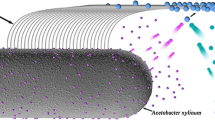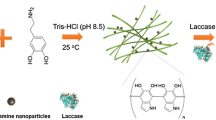Abstract
A biological method is demonstrated to fabricate the polymer–inorganic nanocomposites (PINCs) utilizing bacterium as an efficient and versatile biofactory. Gluconacetobacter xylinum that can produce bacterial cellulose is incubated in the culture medium containing titanium or silica precursor. The PINCs can be acquired under the elaborate control of the culturing condition of G. xylinum, in which the formation of inorganic nanoparticles about several tens of nanometers in size synchronizes the fabrication of reticulated bacterial cellulose membrane composed of dense and finely branched nanofibers about 60–120 nm in diameter. The composition and chemical states, morphology, thermal stability of the inorganic nanoparticles, and nanocomposites were extensively characterized. A tentative mechanism for the formation of PINCs is proposed. It is hoped that this study may establish a generic platform toward facile and green synthesis of nanocomposite materials.








Similar content being viewed by others
References
Ahmad A, Mukerjee P, Mandal D, Senapati S, Khan MI, Kumar R, Sastry M (2002) Enzyme mediated extracellular synthesis of CdS nanoparticles by the fungus, Fusarium oxysporum. J Am Chem Soc 124:12108–12109
Ahmad A, Senapati S, Khan MI, Kumar R, Ramani R, Srinivas V, Sastry M (2003) Intracellular synthesis of gold nanoparticles by a novel alkalotolerant actinomycete, Rhodococcus species. Nanotechnology 14:824–828
Balazs AC, Emrick T, Russell TP (2006) Nanoparticle polymer composites: where two small worlds meet. Science 314:1107–1110
Bansal V, Rautaray D, Ahmad A, Sastry M (2004) Biosynthesis of zirconia nanoparticles using the fungus Fusarium oxysporum. J Mater Chem 14:3303–3305
Bansal V, Rautaray D, Bharde A, Ahire K, Sanyal A, Ahmad A, Sastry M (2005a) Fungus-medicated biosynthesis of silica and titania particles. J Mater Chem 15:2583–2589
Bansal V, Sanyal A, Rautaray D, Ahmad A, Sastry M (2005b) Bioleaching of sand by the fungus Fusarium oxysporum as a means of producing extracellular silica nanoparticles. Adv Mater 17:889–892
Bansal V, Poddar P, Ahmad A, Sastry M (2006) Room-temperature biosynthesis of ferroelectric barium titanate nanoparticles. J Am Chem Soc 128:11958–11963
Coker VS, Telling ND, van der Laan G, Pattrick RAD, Pearec CI, Arenholz E, Tuna F, Winpenny REP, Lloyd JR (2009) Harnessing the extracellular bacterial production of nanoscale cobalt ferrite with exploitable magnetic properties. ACS Nano 3:1922–1928
Crookes-Goodson WJ, Slocik JM, Naik RR (2008) Bio-directed synthesis and assembly of nanomaterials. Chem Soc Rev 37:2403–2412
Dahl JA, Maddux BLS, Hutchison JE (2007) Toward greener nanosynthesis. Chem Rev 107:2228–2269
De Santa Maria LCS, Santos ALC, Oliveira PC, Barud HS, Messaddeq Y, Ribeiro SJL (2009) Synthesis and characterization of silver nanoparticles impregnated into bacterial cellulose. Mater Lett 63:797–799
Eisenstein M (2005) Bacteria find work as amateur chemists. Nat Methods 2:6–7
Evans BR, O’Neill HM, Malyvanh VP, Lee I, Woodward J (2003) Palladium-bacterial cellulose membranes for fuel cells. Biosens Bioelectron 18:917–923
Focher B, Palma MT, Canetti M, Torri G, Cosentino C, Gastaldi G (2001) Structural differences between non-wood plant celluloses evidence from solid state NMR, vibrational spectroscopy and X-ray diffractometry. Ind Crop Prod 13:193–208
Jiang Y, Yang D, Zhang L, Sun Q, Sun X, Li J, Jiang Z (2009) Preparation of protamine-titania microcapsules through synergy between layer-by-layer assembly and biomimetic mineralization. Adv Funct Mater 19:150–156
Klaus T, Joerger R, Olsson E, Granqvist CG (1999) Silver-based crystalline nanoparticles, microbially fabricated. Proc Natl Acad Sci USA 6:13611–13614
Klemm D, Schumann D, Udhardt U, March S (2001) Bacterial synthesized cellulose-artificial blood vessels for microsurgery. Prog Polym Sci 26:1561–1603
Klemm D, Heublein B, Fink H, Bohn N (2005) Cellulose: fascinating biopolymer and sustainable raw material. Angew Chem Int Ed 44:3358–3393
Konishi Y, Ohno K, Saitoh N, Nomura T, Nagamine S, Hishida H, Takahashi Y, Uruga T (2007) Bioreductive deposition of platinum nanoparticles on the bacterium Shewanella algae. J Biotechnol 128:648–653
Korbekandi H, Iravani S, Abbasi S (2009) Production of nanoparticles using organisms. Crit Rev Biotechnol 29:279–306
Kowshik M, Vogel W, Urban J, Kulkarni SK, Paknikar KM (2002) Microbial synthesis of semiconductor PbS nanocrystallites. Adv Mater 14:815–818
Labrenz M, Drischel GK, Thomsen-Ebert T, Gilbert G, Welch SA, Kemner KM, Logan GA, Summons RE, Stasio GD, Bond PL, Lai B, Kelly SD, Banfield JF (2000) Formation of sphalerite (ZnS) deposits in natural biofilms of sulfate-reducing bacteria. Science 290:1744–1747
Li X, Chen S, Hu W, Shi S, Shen W, Zhang X, Wang H (2009) In situ synthesis of CdS nanoparticles on bacterial cellulose nanofibers. Carbohydr Polym 76:509–512
Lu FH, Chen HY (1999) XPS analyses of TiN films on Cu substrates after annealing in the controlled atmosphere. Thin Solid Films 355–356:374–379
Mukherjee P, Ahmad A, Mandal D, Senapati S, Sainkar SR, Khan MI, Parishcha R, Ajaykumar PV, Alan M, Kumar R, Sastry M (2001a) Fungus-medicated synthesis of silver nanoparticles and their immobilization in the mycelial matrix: a novel biological approach to nanoparticle synthesis. Nano Lett 1:515–519
Mukherjee P, Ahmad A, Mandal D, Senapati S, Sainkar SR, Khan MI, Ranani R, Parischa R, Ajayakumar PV, Alam M, Sastry M, Kumar R (2001b) Bioreduction of AuCl4 − ions by the fungus Verticillium sp. and surface trapping of the gold nanoparticles formed. Angew Chem Int Ed 40:3585–3588
Nogi M, Yano H (2008) Transparent nanocomposites based on cellulose produced by bacteria offer potential innovation in the electronics device industry. Adv Mater 20:1849–1852
Park WI, Kim HS, Kwon SM, Hong YH, Jin HJ (2009) Synthesis of bacterial celluloses in multiwalled carbon nanotube-dispersed medium. Carbohydr Polym 77:457–463
Philipse AP, Mass D (2002) Magnetic colloids from magnetotactic bacteria: chain formation and colloidal stability. Langmuir 18:9977–9984
Poliakoff M, Licence P (2007) Sustainable technology: green chemistry. Nature 450:810–812
Pommet M, Juntaro J, Heng JYY, Mantalaris A, Lee AF, Wilson K, Kalinka G, Shaffer MSP, Bismarck A (2008) Surface modification of natural fibers using bacteria: depositing bacterial cellulose natural fibers to create hierarchical fiber reinforced nanocomposites. Biomacromolecules 9:1643–1651
Ray SS, Bousmina M (2005) Biodegradable polymers and their layered silicate nanocomposites: in greening the 21st century materials world. Prog Mater Sci 50:962–1079
Reith F, Etschmann B, Grosse C, Moors H, Benotmane MA, Monsieurs P, Grass G, Doonan C, Vogt S, Lai B, Martinez-Criado G, George GN, Nies DH, Mergeay M, Pring A, Southam G, Brugger J (2009) Mechanisms of gold biomineralization in the bacterium Cupriavidus metallidurans. Proc Natl Acad Sci USA 106:17757–17762
Rittigstein P, Priestley RD, Broadbelt LJ, Torkelson JM (2007) Model polymer nanocomposites provide an understanding of confinement effects in real nanocomposites. Nat Mater 6:278–282
Sanchez C, Julián B, Belleville P, Popall M (2005) Applications of hybrid organic-inorganic nanocomposites. J Mater Chem 15:3559–3592
Stern R, Jedrzejas MJ (2008) Carbohydrate polymers at the center of life’ origins: the importance of molecular processivity. Chem Rev 108:5061–5086
Sun D, Yang J, Wang X (2010) Bacterial cellulose/TiO2 hybrid nanofibers prepared by the surface hydrolysis method with molecular precision. Nanoscale 2:287–292
Wang Y, Wang T, Su Y, Peng F, Wu H, Jiang Z (2005) Remarkable reduction of irreversible fouling and improvement of the permeation properties of poly(ether sulfone) ultrafiltration membranes by blending with Pluronic F127. Langmuir 21:11856–11862
Xie J, Lee JY, Wang DIC, Ting YP (2007) Silver nanoplates: from biological to biomimetic synthesis. ACS Nano 1:429–439
Yano S, Maeda H, Nakajima M, Hagiwara T, Sawaguchi T (2008) Preparation and mechanical properties of bacterial cellulose nanocomposites loaded with silica nanoparticles. Cellulose 15:111–120
Yong P, Rowsen NA, Farr JPG, Harris IR, Macaskie LE (2002) Bioreduction and biocrystalization of palladium by Desulfovibrio desulfuricans NCIMB 8307. Biotechnol Bioeng 80:369–379
Yu JG, Yu HG, Cheng B, Zhao XJ, Yu JC, Ho WK (2003) The effect of calcination temperature on the surface microstructure and photocatalytic activity of TiO2 thin films prepared by liquid phase deposition. J Phys Chem B 107:13871–13879
Zhang D, Qi L (2005) Synthesis of mesoporous titania networks consisting of anatase nanowires by templating of bacterial cellulose membranes. Chem Commun 21:2735–2737
Zhang T, Wang W, Zhang D, Zhang X, Ma Y, Zhou Y, Qi L (2010) Biotemplated synthesis of gold nanoparticle-bacteria cellulose nanofiber nanocomposites and their application in biosensing. Adv Funct Mater 20:1152–1160
Zou H, Wu S, Shen J (2008) Polymer/silica nanocomposites: preparation, characterization, properties, and applications. Chem Rev 108:3893–3957
Acknowledgments
This research is supported by the National Basic Research Program of China (2009CB724700), the Tianjin Natural Science Foundation (No. 08JCYBJC01700), the National Special Fund for State Key Laboratory of Bioreactor Engineering (No. 2060204), the Program for Changjiang Scholars and Innovative Research Team in University from the Ministry of Education of China, and the Program of Introducing Talents of Discipline to Universities (No: B06006).
Author information
Authors and Affiliations
Corresponding author
Rights and permissions
About this article
Cite this article
Geng, J., Yang, D., Zhu, Y. et al. One-pot biosynthesis of polymer–inorganic nanocomposites. J Nanopart Res 13, 2661–2670 (2011). https://doi.org/10.1007/s11051-010-0159-0
Received:
Accepted:
Published:
Issue Date:
DOI: https://doi.org/10.1007/s11051-010-0159-0




